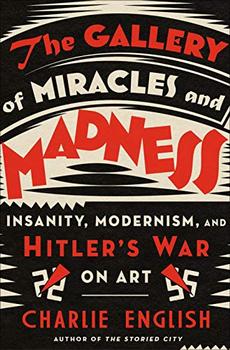Summary | Excerpt | Reviews | Beyond the Book | Readalikes | Genres & Themes | Author Bio

 Book Reviewed by:
Book Reviewed by:
Peggy Kurkowski
Buy This Book
Bühler had always been unusual. He was born on August 28, 1864, at Offenburg, a picturesque town of chiming clocks and steep-pitched roofs in the valley of the Upper Rhine. His mother, Euphrosyne, died young, and his father, who ran a blacksmith's shop from their house on Glaserstraße, married a second time, to Theresia. Where Bühler senior was calm and polite, Franz Karl was boisterous and eccentric, and heard voices from the age of sixteen. He was also intelligent and well-liked, and performed well at school. He enjoyed music and played the violin in a chamber ensemble. But it was at the forge that he would make his reputation. There he was a virtuoso.
In 1871, the Grand Duchy of Baden was incorporated into the new, unified Germany, ruled over by Kaiser Wilhelm I, and Offenburg went with it. The bold imperial nation demanded bold imperial architecture, and Bühler & Son became leading suppliers of ironwork for the castles and grand buildings that were being thrown up all around the region. At the schools of applied arts in Karlsruhe and Munich, Bühler learned to create the most elaborate and fashionable rococo forms. He had a subversive side, too. When the kaiser commissioned a great palace to be built at Strasbourg, in territory conquered from France, Bühler incorporated a caricature of the emperor's face into every handrail, with a mighty nose and Don Quixote mustache. His creative flair soon won him craftsmanship competitions around the country, and in 1893, when he was still in his twenties, his career hit a double high: He was appointed head of the workshop at the Strasbourg School of Arts and Crafts and chosen to represent Germany at the Chicago World's Fair. That summer, as he boarded a liner bound for the United States, this entertaining, brilliant, and somewhat overbearing young man was on course to become one of the most highly regarded artisans in Europe.
The industrial world at that moment was in the midst of transformation, and nowhere in 1893 embodied the change more fully than Chicago. As one contemporary writer put it, the world had changed less since the time of Jesus Christ than it did in the decades before the First World War. In 1870, most people in Western Europe and the United States lived and worked on the land; by 1910, most lived in the cities, drawn in by a raft of new urban professions. London, Paris, and Vienna doubled in size; Munich tripled; Berlin quadrupled; New York grew by a factor of six. Chicago was the most supercharged of them all, expanding faster than any town in history. Barely sixty years old, it was already laying claim to the title of America's second city, and beating out New York to host that showcase of technological and cultural prowess, the World's Fair.
The World's Columbian Exposition, as the 1893 event was officially billed, was the latest of a series of world's fairs that had begun with the 1851 Great Exhibition in London. As Bühler discovered, Chicago's show would be bigger and brasher than all the rest. A seven-hundred-acre site on the shore of Lake Michigan was filled with the fruits of humanity's most technologically advanced era. Twenty-seven million people would visit, the equivalent of almost half the U.S. population at the time. In Paris four years earlier, fairgoers had been astonished by Gustave Eiffel's tower, an ironwork lattice that pierced the sky to the height of a thousand feet. The American riposte, the first Ferris wheel, was also vast—as high as the tallest of the new skyscrapers—but this construction moved. Powered by thousand-horsepower steam engines, it could lift up thirty-eight thousand visitors each day for a view few had ever seen: that of the human world from above.
Excerpted from The Gallery of Miracles and Madness by Charlie English. Copyright © 2021 by Charlie English. All rights reserved. No part of this excerpt may be reproduced or reprinted without permission in writing from the publisher.





The Flower Sisters
by Michelle Collins Anderson
From the new Fannie Flagg of the Ozarks, a richly-woven story of family, forgiveness, and reinvention.

The House on Biscayne Bay
by Chanel Cleeton
As death stalks a gothic mansion in Miami, the lives of two women intertwine as the past and present collide.

The Funeral Cryer by Wenyan Lu
Debut novelist Wenyan Lu brings us this witty yet profound story about one woman's midlife reawakening in contemporary rural China.
Your guide toexceptional books
BookBrowse seeks out and recommends the best in contemporary fiction and nonfiction—books that not only engage and entertain but also deepen our understanding of ourselves and the world around us.